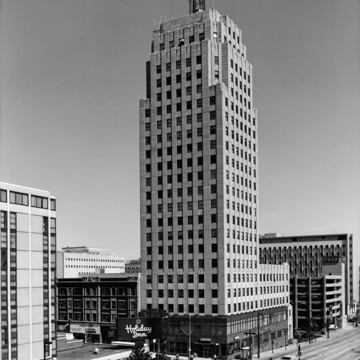Milwaukee’s tallest 1920s skyscraper was designed by a Chicago firm in the Art Deco style. The architects emphasized the height of the twenty-two-story block by placing the vertical surfaces slightly forward of the horizontal ones. Eschewing the traditional projecting cornice atop the building, they allowed the eye to scan uninterrupted up the walls to the sky. The chamfered corners of the three upper sections and inset two top floors taper the building’s silhouette. The skyward sweep culminates in a needle-like radio mast, the last surviving one of its kind in the city. Mariner Tower’s first two floors are clad in polished marble and ornamented with low-relief Art Deco metal castings designed by Arthur Weary. Upper floors are wrapped in smooth Bedford limestone. The entrance, with its handsome grilles, and the marble lobby exhibit beautiful examples of the geometric stylization and simplified forms characteristic of Art Deco.
You are here
Wisconsin Tower (Mariner Tower)
If SAH Archipedia has been useful to you, please consider supporting it.
SAH Archipedia tells the story of the United States through its buildings, landscapes, and cities. This freely available resource empowers the public with authoritative knowledge that deepens their understanding and appreciation of the built environment. But the Society of Architectural Historians, which created SAH Archipedia with University of Virginia Press, needs your support to maintain the high-caliber research, writing, photography, cartography, editing, design, and programming that make SAH Archipedia a trusted online resource available to all who value the history of place, heritage tourism, and learning.









